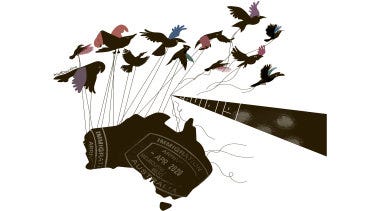
What if he was right? he heard them ask, the very last of the Watchers on the Watch in these stricken times.
But of course he had been right.
He has been tossed off the platform Medium, and his publication A Sense of Place Magazine, essentially for telling the truth.
The truth was not contained in government messaging. It was not contained in the mainstream media. The only truth was coming from the perimeter. There was no relief. They have been taken over by the worst of the worst.
He sat in the almost empty train carriages, rustling to and from work, and read over and over again the advertising slogans about the Australian Minerals Council, that is the very very very big end of town, that is the same end of town to which this rotten government was completely hostage, saying that we needed to look at minerals in a new way, mining in a new way, that mining was helping to cure cancer. That it was their donations that was saving the poor and unfortunate,
Only a brief instant in time before such blatant advertising on a public transit train would have been laughable. It would instead have promoted messages about helping your neighbours, or charities, thinking of others, bush fire relief, all good causes. There was nothing good about this evil mob.
They plundered the land where his ancestors had been. They gorged themselves at the trough. They deluded an entire public and millions and millions of people into throwing themselves into serfdom. They created a new slave class. He watched the yellow vests swarm off the train at Central, off to their various slave like jobs. All of them lucky, all of a sudden, to be in work.
The only voice is held up against the barrage of government messaging about the coronavirus, deliberately inciting panic into the population, had been coming from the margins of electronic publications, obscure academic journals, things read only by people who read.
Now it was all coming true, and those peripheral messages were moving straight to the mainstream.
How did any of it make sense?
How did quarantining the healthy and bankrupting in an entire economy make any sense at all? Where was all this money coming from, these daily multi-billion dollar announcements funding this funding that funding the other.
Tens of millions of dollars to their media mates, in one of the most blatant of lies, to protect journalism, this government that had done more to destroy journalism and misinform the public than any in the nation’s history.
Now they would all be paying the price for ignorance. Now the crashed fortunes of much of the population, as the rich got even richer, would lead straight to the pit, to chaos in the streets, to terrible annihilation. And that isolation would be both physical and of the spirit. This place which had embraced a kind of lunatic madness. A place where a people had been led like sheep, where they would not be uplifted but manipulated, would be plundered not encouraged.
Empty seats in empty chairs, bequeathed by empty hearts.
It was obvious from the very beginning that more harm would be done by the government's actions than the virus would have ever done.
RELATED STORIES:
https://www.abc.net.au/radio/programs/the-signal/who-will-pay-the-covid-19-bill/12213650
Australians were warned 150,000 of us could die of COVID-19 if we weren't careful.
As it happens, we were.
But economists are starting to wonder how accurate that worst-case scenario modelling was.
There's one school of thought that argues we've gone too far in avoiding something that was very unlikely to happen
Today, we're counting the human and economic cost of COVID-19 and asking, who’s going to pay for it?
THE DEBATE TURNS:
Reserve Bank governor Philip Lowe told us last month: "We need to remember that once the virus is satisfactorily contained, all those factors that have made Australia such a successful and prosperous country will still be there."
Maybe. What about migration? More than half the nation's population growth since 2005 has come from overseas migration. High levels of immigration, especially skilled migration, helped sustain Australia’s 28 years of uninterrupted economic growth.

Illustration: Matt Davidson CREDIT:
But COVID-19 has closed our international borders. Temporary migrants are going home. No new migrants are coming for the foreseeable future. Borders are likely to stay closed well after all other restrictions ease. When we re-open the borders — in six, 12, or 24 months – migrants will not return immediately.
While Australia's high level of migration played a key role in our economic prosperity, in recent years the shape and size of our intake has hurt many Australian workers, contributing to unemployment, underemployment and low wage growth.
The post-COVID-19 question we must ask now is this: when we restart our migration program, do we want migrants to return to Australia in the same numbers and in the same composition as before the crisis?
Our answer should be no. Our economic recovery must help all Australians get back on their feet, and to do that we need a migration program that puts Australian workers first.



